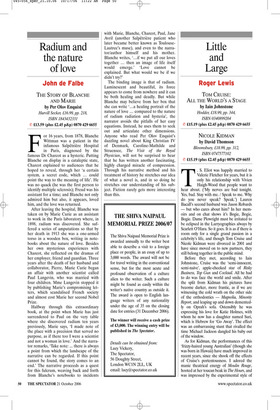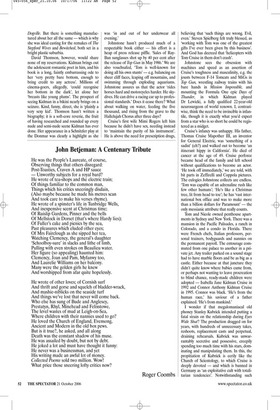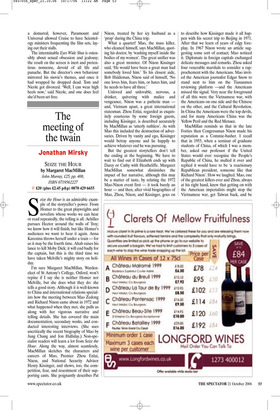Little and Large
Roger Lewis
TOM CRUISE: ALL THE WORLD’S A STAGE by Iain Johnstone Hodder, £18.99, pp. 344, ISBN 0340899204 ✆ £15.19 (plus £2.45 p&p) 0870 429 6655 NICOLE KIDMAN by David Thomson Bloomsbury, £18.99, pp. 312, ISBN 0747577102 ✆ £15.19 (plus £2.45 p&p) 0870 429 6655 T. S. Eliot was happily married to Valerie Fletcher for years, but it is only his relationship with Vivien Haigh-Wood that people want to hear about. (‘My nerves are bad tonight. Yes, bad. Stay with me. / Speak to me. Why do you never speak? Speak.’) Lauren Bacall’s second husband was Jason Robards — but who cares about him? In her memoirs and on chat shows it’s Bogie, Bogie, Bogie. Dame Plowright must be irritated to be eclipsed in the Larryographies always by Scarlett O’Hara. So it goes. It is as if there is room only for a single grand passion in a celebrity’s life, and though Tom Cruise and Nicole Kidman were divorced in 2001 and have since moved on to new partners, they still belong together in the public mind.
Before they met, according to Iain Johnstone, Cruise was the ‘semi-innocent, semi-naive’, apple-cheeked star of Risky Business, Top Gun and Cocktail. All he had to do was face the world and smile. After the split from Kidman his pictures have become darker, more frantic, as if we are witnessing the cold wrath on the other side of the orthodontics — Magnolia, Minority Report, and leaping up and down dementedly on Oprah’s sofa. Ostensibly he was expressing his love for Katie Holmes, with whom he now has a daughter named Suri, which is Hebrew for ‘Go Away’. The effect was an embarrassing stunt that rivalled the time Michael Jackson dangled his baby out of the window.
As for Kidman, the performances of this ‘frizzy-haired young Australian’ (though she was born in Hawaii) have much improved in recent years, since she shook off the effects of Cruise’s portentousness. I adored the manic theatrical energy of Moulin Rouge, hooted at her toucan beak in The Hours, and was impressed by the experimental style of Dogville. But there is something manufactured about her all the same — which is why she was ideal casting for the remakes of The Stepford Wives and Bewitched, both set in a bright plastic suburbia.
David Thomson, however, would share none of my reservations. Kidman brings out the adolescent romantic poet in him, and his book is a long, faintly embarrassing ode to her ‘very pretty bare bottom, enough to bring credit to any actress’. Millions of cinema-goers, allegedly, ‘could recognise her bottom in the dark’, let alone her ‘breasts like young plums’. The prospect of seeing Kidman in a bikini nearly brings on a seizure. Kind, funny, direct, she is ‘plainly a very sexy kid’. Thomson hasn’t written a biography; it is a soft-core reverie, the fruit of having researched and rounded up every nude and semi-nude scene Kidman has ever done. Her appearance in a Schnitzler play at the Donmar was clearly a highlight as she was ‘in and out of her underwear all evening.’ Johnstone hasn’t produced much of a respectable book either — his effort is a heap of press release piffle. ‘Sales of RayBan sunglasses shot up by 40 per cent after the release of Top Gun in May 1986.’ We are also vouchsafed, ‘Tom is well-known for doing all his own stunts’ — e.g. balancing on sheer cliff faces, leaping off mountains, and swimming through exploding aquariums. Johnstone assures us that the actor ‘rides horses hard and motorcycles harder. He skydives. He can drive a racing car up to professional standards.’ Does it cease there? What about walking on water, feeding the five thousand, and rising from the grave to the Hallelujah Chorus after three days?
Cruise’s first wife Mimi Rogers left him because he didn’t have sex, needing instead to ‘maintain the purity of his instrument’. He is above the need for prescription drugs, believing that ‘such things are wrong. Evil, even.’ Steven Spielberg felt truly blessed, as ‘working with Tom was one of the greatest gifts I’ve ever been given by this business’. And God has decreed that ‘helicopters with Tom Cruise in them don’t crash’.
Johnstone sees the obsession with machines and speed as an assertion of Cruise’s toughness and masculinity, e.g. the jousts between F-14 Tomcats and MiGs in Top Gun, wrestling railway trains with his bare hands in Mission Impossible, and mounting the Formula One epic Days of Thunder, in which Kidman played Dr Lewicki, a fully qualified 22-year-old neurosurgeon of world renown. I, contrariwise, think the need to be invincible is infantile, though it is exactly what you’d expect from a star who is so short he could be registered as a midget.
Cruise’s infancy was unhappy. His father, Thomas Cruise Mapother III, an inventor for General Electric, was ‘something of a sadist’ (eh?) and walked out to become ‘an itinerant hippy in California’. He died of cancer at the age of 49. Cruise perforce became head of the family and left school without qualifications to become an actor. ‘He took off immediately,’ we are told, with bit parts in Zeffirelli and Coppola pictures. The eulogies Johnstone collects are endless. ‘Tom was capable of an adrenaline rush like few other humans’; ‘He’s like a Christmas tree, lit from head to toe’; he has ‘vast international box office and was to make more than a billion dollars for Paramount’ — the only messianic attribute that really counts.
Tom and Nicole owned penthouse apartments in Sydney and New York. There was a mansion in the Pacific Palisades, a ranch in Colorado, and a condo in Florida. There were French chefs, Italian professors, personal trainers, bodyguards and nannies on the permanent payroll. The entourage commuted from one palace to another in a private jet. Any trailer parked on a sound stage had to have marble floors and be as big as a castle. Either because at that juncture they didn’t quite know where babies came from, or perhaps not wanting to leave procreation to blind chance, ready-made children were adopted — Isabella Jane Kidman Cruise in 1992 and Connor Anthony Kidman Cruise in 1995. Connor was black. ‘He’s from the human race,’ his saviour of a father explained. ‘He’s from mankind.’ I wonder if that megalomaniacal old phoney Stanley Kubrick intended putting a fatal strain on the relationship during Eyes Wide Shut? The production dragged on for years, with hundreds of unnecessary takes, reshoots, replacement casts and perpetual, draining rehearsals. Kubrick was unwarrantably secretive and possessive, creepily spending too much time with his stars, dominating and manipulating them. In this, the propitiation of Kubrick is eerily like the Church of Scientology, to which Cruise is deeply devoted — and which is banned in Germany as ‘an exploitative cult with totalitarian tendencies’. Notwithstanding such a demurral, however, Paramount and Universal allowed Cruise to have Scientology ministers frequenting the film sets, laying out their stalls.
The interminable Eyes Wide Shut is ostensibly about sexual obsession and jealousy; the result on the screen is inert and pretentious nonsense, devoid of all life and panache. But the director’s own behaviour mirrored his movie’s themes, and once it had wrapped he dropped dead. Tom and Nicole got divorced. ‘Well, I can wear high heels now,’ said Nicole, and one does feel she’d been set free.




































































































 Previous page
Previous page